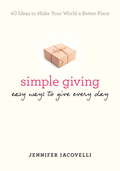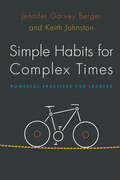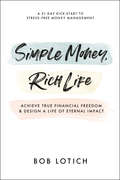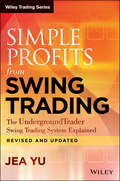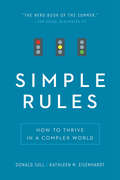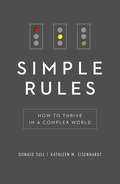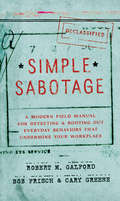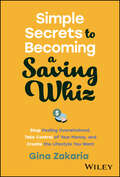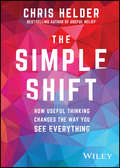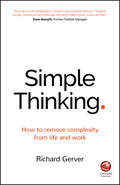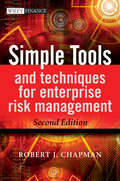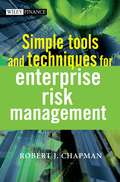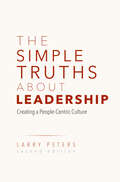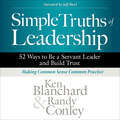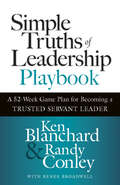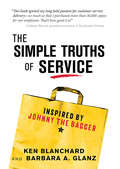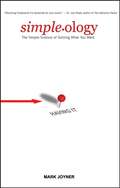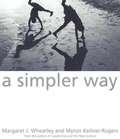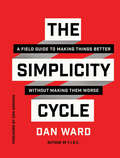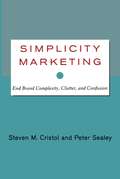- Table View
- List View
Simple Giving
by Jennifer IacovelliYou can make a difference on a daily basis, and it's not as difficult as you might think. Simple Giving includes more than 40 ideas to make the world a better place. Most people think they have to donate a lot of time and money in order to make a difference. But there are simple ways to integrate giving into our personal and professional lives that don't involve either. In Simple Giving, Jennifer Iacovelli shows us how to make giving a part of our daily routines. It can involve something as simple as holding the door open for a stranger or paying someone else's toll, which will brighten that person's day. We can also think about ways to make sustainability and social good a part of our business models. After working in the nonprofit sector and soliciting and coordinating donations for ten years, Iacovelli became frustrated with the disconnect between givers and receivers. Givers (or potential givers) didn't realize how much of an impact they could make, while recipients couldn't thank the organization enough. In Simple Giving, Iacovelli inspires us with the stories of how people ranging from moms to social entrepreneurs are giving back in creative ways. By being more mindful of how our actions impact others and taking steps toward positive change, we also live happier and more fulfilled lives.From the Trade Paperback edition.
A Simple Graphical Framework for Use in The Role of Government in Market Economies (RoGME)
by Matthew C. WeinzierlIndustry and Background Note
Simple Habits for Complex Times: Powerful Practices for Leaders
by Keith Johnston Jennifer Garvey BergerWhen faced with complex challenges or uncertain outcomes, many leaders believe that if they are smart enough, work hard enough, or turn to the best management tools, they will be able to find the right answer, predict and plan for the future, and break down tasks to produce controllable outcomes. But, what are leaders to do when this isn't the case? In complex situations, prediction, control, and the right answer are illusions. Rather than offering one-size-fits-all tips and tricks in pursuit of these mirages, Simple Habits for Complex Times provides three integral practices that enable leaders to navigate the unknown. By taking multiple perspectives, asking different questions, and seeing more of their system, leaders can better understand themselves, their roles, and the world around them. They can become more nimble, respond with agility, and guide their organizations to thrive in an ever-shifting business landscape. The more leaders use these simple habits, the more they enhance their performance and solve increasingly common, sticky business issues with greater acumen. Whether in large or small organizations, in government or the private sector, in the U. S. or overseas, leaders will turn to this book as a companion that helps them grow into the best version of themselves.
Simple, Implementable Fiscal Policy Rules
by Michael Kumhof Douglas LaxtonA report from the International Monetary Fund.
Simple Money, Rich Life: Achieve True Financial Freedom and Design a Life of Eternal Impact
by Bob LotichA hope-filled money guide to increase savings, earnings, and giving and actually enjoy it all while designing a life of freedom and eternal impact, from the founder of SeedTime Money.Broken down and stranded 1,000 miles from home with only $7 left in his bank account, Bob Lotich had reached his breaking point. He was stuck in a dead-end job, living paycheck-to-paycheck, and overwhelmed by debt. Bob had been following the world's advice with money and this was the fruit of it. In desperation, he cried out to God for wisdom, for a different way. The answer was a simple four-part formula, one based on timeless biblical principles, and, most important, it worked. After applying this simple formula, Bob discovered that his financial stress melted away and he finally felt fully in control of his money. As he continued to follow the four steps, he paid off over $400,000 in debt, reached a personal goal of giving $1 million by age 40, and achieved a level of financial freedom he never dreamed possible. In his casual and approachable style, Bob (along with his fun-loving wife, Linda) shares everything he learned about achieving true financial freedom, including: • How to create a money system so you can spend less time and get better results • The One-Category Budget: get 80% of the results with 20% of the work • The four keys to earning more in the digital era • How to automate your way to financial success in less than 10 minutes • The secrets of a six-figure giver • Three credit card rules that banks don&’t want you to know • How to save $100s each month while still buying what you love • And much more! Whether you are doing &“fine&” or are in a financial crisis, the included 21-day kick-start will leave you with specific action items to guide you to success. You can have financial security, peace, significance, and eternal impact. Let Bob show you how to reimagine money as it was meant to be: simple.
A Simple Problem: Real World Strategies for Managing First Impressions, Scoping an Engagement, and Performing Situation Analysis with Limited Information
by Patricia Gorman Clifford Jay Barney"What I Didn't Learn in Business School" follows new consultant Justin Campbell as he joins an elite team hired by a chemical firm to assess the potential of a newly developed technology. In this fictional account, authors Jay Barney and Trish Gorman Clifford take you into the mind of a new consultant as he encounters the challenges of applying business school lessons in the real-world-the way a traditional book on business strategy never could. This chapter introduces Justin on his first day as he meets his new colleagues, prepares for his first client meetings, and confronts the complexities of organizational politics as he begins to gather information on the client's business. This chapter was originally published as Chapter 1 of "What I Didn't Learn in Business School: How Strategy Works in the Real World."
Simple Profits from Swing Trading
by Jea YuThere are so many trading systems out there today, each one claiming to have the secret that will bring windfall returns. Some may fare well in rising markets, but all too often leave the trader struggling to keep their head--and capital--up when the market starts to fall. Doesn't sound too reliable, does it? The Underground Trader Swing Trading system is unlike any other. Having been meticulously forged by hand from hours of active market participation and analysis from over a decade, it is an all-encompassing system that performs strong when the market is rising and perhaps even stronger when it is falling. It functions well in every market condition, ensuring that traders can rely on it no matter how the market moves. This revised book from renowned trader and president of UndergroundTrader.com, Jea Yu, provides all of the information necessary to successfully begin swing trading today. You will learn: * How to break down and grind away any stock piece by piece, allowing you to quantify and analyze it on the fly, * To build a solid foundation using the highest probability setup--the perfect storm, * A step-by-step process of how to plan and execute a trade to ensure the highest available return, and * When to buy long or sell short and exactly the criteria to identify and look for before making these moves. Also included in this e-book are real-life examples and charts as well as an in-depth look at how the Underground Trader system really works, what its chat rooms and alerts look like, and how you can use the platform to exponentially increase your swing trading knowledge and --in turn-- your profits. Knowing the information provided in this e-book will help you to boost your returns and minimize losses with just a few simple strategies that will leave you wishing you'd been an Underground Trader years ago.
Simple Regression Mathematics
by Frances X. Frei Dennis CampbellDescribes the underlying mathematics of regression.
Simple Rules: How to Thrive in a Complex World
by Kathleen M. Eisenhardt Donald SullHOW SIMPLICITY TRUMPS COMPLEXITY IN NATURE, BUSINESS, AND LIFE Complexity surrounds us. We have too much email, juggle multiple remotes, and hack through thickets of regulations from phone contracts to health plans. But complexity isn't destiny. Sull and Eisenhardt argue there's a better way. By developing a few simple yet effective rules, people can best even the most complex problems. In Simple Rules, Sull and Eisenhardt masterfully challenge how we think about complexity and offer a new lens on how to cope. They take us on a surprising tour of what simple rules are, where they come from, and why they work. The authors illustrate the six kinds o f rules that really matter - for helping artists find creativity and the Federal Reserve set interest rates, for keeping birds on track and Zipcar members organized, and for how insomniacs can sleep and mountain climbers stay safe. Drawing on rigorous research and riveting stories, the authors ingeniously find insights in unexpected places, from the way Tina Fey codified her experience at Saturday Night Live into rules for producing 30 Rock (rule five: never tell a crazy person he's crazy) to burglars' rules for robbery ("avoid houses with a car parked outside") to Japanese engineers mimicking the rules of slime molds to optimize Tokyo's rail system. The authors offer fresh information and practical tips on fixing old rules and learning new ones. Whether you're struggling with information overload, pursuing opportunities with limited resources, or just trying to change your bad habits, Simple Rules provides powerful insight into how and why simplicity tames complexity.
Simple Rules: How to Thrive in a Complex World
by Kathleen Eisenhardt Donald SullLife gets more complicated every day. Whether you're struggling with information overload, attempting to act effectively with limited resources or trying to change bad habits - all you need is Simple Rules. Donald Sull and Kathleen Eisenhardt have spent the last decade working with businesses around the world, and have developed a set of highly effective, tried-and-tested rules to help tackle complex problems, whatever they are. In Simple Rules they share them with you.So, how do we make the best decisions when deluged with data? How do we solve problems across global networks? And how do we pinpoint what exactly it is that is holding us back from success? Sull and Eisenhardt have distilled two careers-worth of research, experience and work into a much needed guide to achieving our most pressing personal and professional objectives, from overcoming insomnia to becoming a better manager or a smarter investor. Full of tips, illuminating case studies and clear advice, Simple Rules provides the tools you need.
Simple Sabotage: A Modern Field Manual for Detecting and Rooting Out Everyday Behaviors That Undermine Your Workplace
by Robert M. Galford Bob Frisch Cary GreeneInspired by the Simple Sabotage Field Manual released by the Office of Strategic Services in 1944 to train European resistors, this is the essential handbook to help stamp out unintentional sabotage in any working group, from major corporations to volunteer PTA committees.In 1944, the Office of Strategic Services (OSS)--the predecessor of today's CIA--issued the Simple Sabotage Field Manual that detailed sabotage techniques designed to demoralize the enemy. One section focused on eight incredibly subtle--and devastatingly destructive--tactics for sabotaging the decision-making processes of organizations. While the manual was written decades ago, these sabotage tactics thrive undetected in organizations today: Insist on doing everything through channels. Make speeches. Talk as frequently as possible and at great length. Refer all matters to committees. Bring up irrelevant issues as frequently as possible. Haggle over precise wordings of communications. Refer back to matters already decided upon and attempt to question the advisability of that decision. Advocate caution and urge fellow-conferees to avoid haste that might result in embarrassments or difficulties later on. Be worried about the propriety of any decision.Everyone has been faced with someone who has used these tactics, even when they have meant well. Filled with proven strategies and techniques, this brief, clever book outlines the counter-sabotage measures to detect and reduce the impact of these eight classic sabotage tactics to improve productivity, spur creativity, and engender better collegial relationships.
Simple Secrets to Becoming a Saving Whiz: Stop Feeling Overwhelmed, Take Control of Your Money, and Create the Lifestyle You Want
by Gina ZakariaDiscover the power of simplicity in the quest for financial empowerment In Simple Secrets to Becoming a Saving Whiz: Stop Feeling Overwhelmed, Take Control of Your Money, and Create the Lifestyle You Want, veteran financial educator Gina Zakaria delivers a compelling discussion of leveraging simplicity to approach personal finance. You’ll learn to create momentum and foster financial empowerment as you reach successive, intentional milestones that build your sense of progress and accomplishment. The author shares her own personal debt story and how she accumulated over $105,000 in credit card debt through tiny, seemingly insignificant, actions. She also demonstrates how equally small steps—when taken intentionally—can help you climb your way out of debt and into a place of financial security. You’ll also find: Strategies for breaking down your goals into subgoals that can be easily accomplished Grocery budgeting tips, along with simple shopping strategies, home systems, and effective routines for saving money with food and meal prep Methods for understanding the basics of bills, bill saving strategies, and debt savings using the author’s popular “3A Method” An essential and effective resource for anyone interested in improving their financial outlook, Simple Secrets to Becoming a Saving Whiz is perfect for everyone who hopes to save more money, budget better, and make real, measurable changes to their personal financial habits.
The Simple Shift: How Useful Thinking Changes the Way You See Everything
by Chris HelderReframe challenges as opportunities, not obstaclesThere is a mountain of hype around positive thinking. But have you noticed that positive thinking doesn’t, well, work? That’s because positivity is just an emotion, and at the end of the day it doesn’t change the reality of the situations we face. The Simple Shift turns positive thinking on its head and transforms it into something practical – a way of adopting beliefs that can change the way you see reality and make major obstacles into easily resolvable issues.This book helps you develop the self-awareness to know when and how your thoughts are holding you back. Instead of just trying to ignore negative thoughts or pretend that problems don’t exist, why not actually change them, using useful thinking? Control your perception and start to turn your life around with The Simple Shift.• Overcome life’s obstacles by transforming the way you perceive problems• Discover why what’s “true” doesn’t matter as much as what’s “useful” • Triumph when times are tough by adopting a simple shift in thinking• Uncover the valuable lessons you've already learned by overcoming past challengesThis book provides a clear and practical path for retraining your brain to see opportunities rather than obstacles. It’s not about putting on rose-coloured glasses and pretending that problems don’t exist. Rather, you can choose to train your mindset towards what is useful, guiding you to better outcomes in life, love and work.
A Simple Stochastic Approach to Debt Sustainability Applied to Lebanon
by Julian Di Giovanni Edward GardnerA report from the International Monetary Fund.
Simple Thinking: How to remove complexity from life and work
by Richard GerverSimple behaviours that unclutter your mind and help you realise your true potential Awaken your passion and tap into your inner greatness as you remove the metaphorical clutter from your life with Simple Thinking. You'll learn how to expand your mind and understand your true potential through the power of thinking simply, while stripping back the jargon and digging to the core of any obstacle in your way. Let's be honest, life is full of unnecessary complexity and it's left most of us confused, angry and disenfranchised. This book will help you to remove the baggage, cut through the clutter and begin your smooth path to success. Learn how to: Live and act with resiliency, authenticity and passion Learn to trust your instincts again and see the world through new eyes Recalibrate your thoughts, behaviours and actions Declutter your mind, streamline your day and be successful at life Simple wisdom, simply shared, is personal development unplugged - and when you begin peeling back the layers to expose the heart of the problem, you become well-equipped to devise a simpler, yet more effective solution. Simple Thinking will help you in achieving this state of clarity and confidence.
Simple Tools and Techniques for Enterprise Risk Management (The\wiley Finance Ser. #631)
by Robert J. ChapmanYour business reputation can take years to build—and mere minutes to destroy The range of business threats is evolving rapidly but your organization can thrive and gain a competitive advantage with your business vision for enterprise risk management. Trends affecting markets—events in the global financial markets, changing technologies, environmental priorities, dependency on intellectual property—all underline how important it is to keep up to speed on the latest financial risk management practices and procedures. This popular book on enterprise risk management has been expanded and updated to include new themes and current trends for today's risk practitioner. It features up-to-date materials on new threats, lessons from the recent financial crisis, and how businesses need to protect themselves in terms of business interruption, security, project and reputational risk management. Project risk management is now a mature discipline with an international standard for its implementation. This book reinforces that project risk management needs to be systematic, but also that it must be embedded to become part of an organization's DNA. This book promotes techniques that will help you implement a methodical and broad approach to risk management. The author is a well-known expert and boasts a wealth of experience in project and enterprise risk management Easy-to-navigate structure breaks down the risk management process into stages to aid implementation Examines the external influences that bring sources of business risk that are beyond your control Provides a handy chapter with tips for commissioning consultants for business risk management services It is a business imperative to have a clear vision for risk management. Simple Tools and Techniques for Enterprise Risk Management, Second Edition shows you the way.
Simple Tools and Techniques for Enterprise Risk Management
by Robert J. ChapmanYour business reputation can take years to build--and mere minutes to destroyThe range of business threats is evolving rapidly but your organization can thrive and gain a competitive advantage with your business vision for enterprise risk management. Trends affecting markets--events in the global financial markets, changing technologies, environmental priorities, dependency on intellectual property--all underline how important it is to keep up to speed on the latest financial risk management practices and procedures.This popular book on enterprise risk management has been expanded and updated to include new themes and current trends for today's risk practitioner. It features up-to-date materials on new threats, lessons from the recent financial crisis, and how businesses need to protect themselves in terms of business interruption, security, project and reputational risk management.Project risk management is now a mature discipline with an international standard for its implementation. This book reinforces that project risk management needs to be systematic, but also that it must be embedded to become part of an organization's DNA. This book promotes techniques that will help you implement a methodical and broad approach to risk management.The author is a well-known expert and boasts a wealth of experience in project and enterprise risk managementEasy-to-navigate structure breaks down the risk management process into stages to aid implementationExamines the external influences that bring sources of business risk that are beyond your controlProvides a handy chapter with tips for commissioning consultants for business risk management servicesIt is a business imperative to have a clear vision for risk management. Simple Tools and Techniques for Enterprise Risk Management, Second Edition shows you the way.
The Simple Truths About Leadership: Turning Your People Into Your Partners
by Larry PetersIn the middle of the last decade, businesses have suffered serious harm due to the world-wide economic slowdown/great recession, geopolitical tensions and conflicts, and the very unpredictable nature of our government. In the process of staying the course, many business leaders have made a number of decisions and have taken a number of actions that have done harm to their relationships with their own employees. The resultant psychological contract told employees that their leaders were in it for themselves, for owners and stockholders, for positive reports from Wall Street, for their customer base … for every stakeholder group other than the people who work there. This book offers a road map for creating a more engaged, committed workforce by adopting and maintaining a People-Centric culture. <P><P> After describing why commitment and engagement are so important today, the author speaks to how mindsets that reflect an older business reality need to change before any sustainable change in behavior and work culture can occur. This book underscores the role that leaders need to play by embracing 10 Simple Truths that underlie long-term, sustainable business success. Some argue that we may be approaching the next recession, and it is in those down times that businesses will need their people most. Now is the time for leaders to proactively start earning that support and turn their people into their partners rather than just their hired hands. <P><P> With a case study that describes a true People-Centric leader and that demonstrates what it takes to lead a culture change, this book is a call to action for leaders everywhere to (a) become a People-Centric leader, (b) earn the right to lead others toward this end, and (c) align their company culture with the mindset and capabilities needed to produce and sustain long-term business success. <P><P> If you are not getting the best from your people, read this book with the goal of turning that around. You will find it to be a good blueprint for leaders who attempt to create a more People-Centric culture.
Simple Truths of Leadership: 52 Ways to Be a Servant Leader and Build Trust
by Dr. Ken Blanchard Randy ConleyLeadership legend and bestselling author Ken Blanchard and trust expert and thought leader Randy Conley present this carefully curated collection of fifty-two essential leadership principles that are easy to implement and practice.Effective leadership is an influence process where leaders implement everyday, commonsense approaches that help people and organizations thrive. Yet somehow, many of these fundamental principles are still missing from most workplaces. In Simple Truths of Leadership, legendary servant leadership expert Ken Blanchard, whose books have sold millions of copies worldwide, and his colleague Randy Conley, known and recognized for his many years of thought leadership and expertise in the field of trust, share fifty-two Simple Truths about leadership that will help leaders everywhere make commonsense leadership common practice.Readers will discover profound, memorable, and in some cases counterintuitive leadership wisdom such as• Who should make the first move to extend trust• What role a successful apology plays in building trust • When to use different strokes (leadership styles) for different folks—and for the same folks• Where the most important part of leadership happens• How to create autonomy through boundaries• Why the key to developing people is catching them doing something right A fun, easy read that will make a positive difference in leadership and organizational success, Simple Truths of Leadership will show readers how to incorporate simple but essential practices into their leadership style, build trust through servant leadership, and enhance their own lives and the lives of everyone around them.
Simple Truths of Leadership Playbook: A 52-Week Game Plan for Becoming a Trusted Servant Leader
by Ken Blanchard Randy ConleyLeadership legend and bestselling author Ken Blanchard returns with trust expert and thought leader Randy Conley to present a structured playbook based on the bestselling Simple Truths of Leadership.The companion playbook to Simple Truths of Leadership expands on the book's 52 essential principles of servant leadership and trust building. This structured playbook provides weekly prompts and exercises to help you track your progress toward your leadership goals. It focuses on one Simple Truth per week and includes: A summary of each Simple Truth A game plan for using each truth in your workplace, including thought-provoking questions and exercises to challenge your thinking and cause you to consider new ideas about leadership A Call to Action to Try It This WeekWith so much of today's workforce feeling disengaged from the work they do, it's critical for leaders to move away from self-serving methods and embrace servant leadership to put their followers' needs before their own. And by journaling alongside servant leadership principles, you will be able to turn the common sense behind these simple truths into common practice for you and your organization.
The Simple Truths of Service: Inspired by Johnny the Bagger
by Barbara Glanz Ken BlanchardYour competitive edge in today's business environment is all about the power of loyalty. So if you want to succeed, it's time to think outside the box of traditional customer service. The Simple Truths of Service is an inspiring true story about Johnny, a very special young man whose creative choices will spark the way your company approaches their clients. By putting his own personal mark on each customer interaction, Johnny makes it clear that the bottom line of service is to lead with the heart. His story, along with many others, provide a tool kit for the success of your company. After reading this book, your service team will be bursting with new ways to stand out from the crowd and really make a difference.
Simpleology
by Mark JoynerSuccess is simple, and scientifically reproducible, if you know the 5 LawsSimpleology proves that success and happiness are easier to achieve than most people think they are. In fact, people can almost guarantee their own success simply by following a few simple rules. These "5 Laws of Simpleology" aren't new; they've been around forever. Throughout history, these 5 laws have helped the world's greatest minds amass fortunes and forge new paths. But until now, no one has committed them to paper in so simple and straightforward a style as Mark Joyner has here. Applicable to any challenge or goal and irrefutably commonsense, these 5 laws form the basis for almost any successful person or endeavor. Simpleology explains the 5 laws in detail and shows readers how to apply them to every aspect of their lives.Mark Joyner (Auckland, New Zealand) is a leading authority on Internet marketing. The former CEO of Aesop Marketing Corp., he is the author of four previous books, including The Irresistible Offer (0-471-73894-8) and The Great Formula (0-471-77823-0), both from Wiley.
A Simpler Way
by Margaret J. Wheatley Myron Kellner-RogersWe want life to be less arduous and more delightful. We want to be able to think differently about how to organize human activities. Our book springs from these desires. It explores a different way of thinking about life and about how organizing might occur. Our primary question is: How could we organize human endeavor if we developed different understandings of how life organizes itself? We ask this question for all of us, for there is no one who is unaffected by the organizations we humans have created.
The Simplicity Cycle
by Dan WardThe Simplicity Cycle is an engaging and accessible field guide that equips readers with practical tools to produce elegant, effective designs. It takes a deep but lighthearted look at the way complexity enhances or diminishes the things we make and use, from PowerPoint presentations and pizzas to spacecraft and software, and shows readers why simplicity is the key to innovation and good design--whether you're creating new products, services, or consumer experiences. e suggests a number of techniques for identifying the problem and fixing it, including how to overcome several types of wrongheaded thinking--such as the idea that complexity and quality are the same. In clear, compelling language, and using his trademark mix of examples from research, personal experience, and pop culture, Ward offers a universal concept, visually described with a single, evolving diagram.Ideal for business leaders and technologists, The Simplicity Cycle is helpful for anyone looking to simplify and improve everything we do, whether we work in an office, at home, or at the Pentagon.
Simplicity Marketing
by Peter Sealey Steven M. CristolFor more than half a century, marketers have bombarded customers with more and more choices in products and services. What is the result? Unprecedented anxiety. Our mental circuit breakers are on overload. In fact, pioneering brand strategists Steven M. Cristol and Peter Sealey assert that we have reached our manageable threshold for making decisions -- and a watershed in product proliferation. In this pathbreaking book, the authors argue with compelling evidence that the next generation of marketing successes will belong to those brands that simplify customers' lives or businesses in ways that are inextricably tied to brand and product positioning. They contend that if a brand is not reducing customer stress, it is creating it -- and it is vulnerable to losing market share to more customer-empathetic competitors. Writing especially for product or brand managers who are struggling to simplify their portfolios, Cristol and Sealey have created a breakthrough framework that is itself a lesson in simplicity. After presenting two essential guideposts for managers to assess where their brand sits on the stress spectrum, the authors turn to the heart of Simplicity Marketing -- the 4 R's of simplification: Replace, Repackage, Reposition, and Replenish. Using scores of real-world company examples, Cristol and Sealey show how each of the 4 R's interacts with the others in powerful ways to relieve customer stress and how these strategies may be executed individually or in combination to build brand loyalty. Here for the first time are ten specific strategies to relieve customer stress through consolidating, aggregating, or integrating products and services, repositioning brands for more relevance to stress reduction, and decluttering customers' decision-making requirements. The final pages of this brilliant manifesto for a simplicity revolution provide a guide to managing simplicity strategies, leveraging information technology to simplify rather than complicate customers' lives, and integrating all the tools in the book into an executional blueprint.
